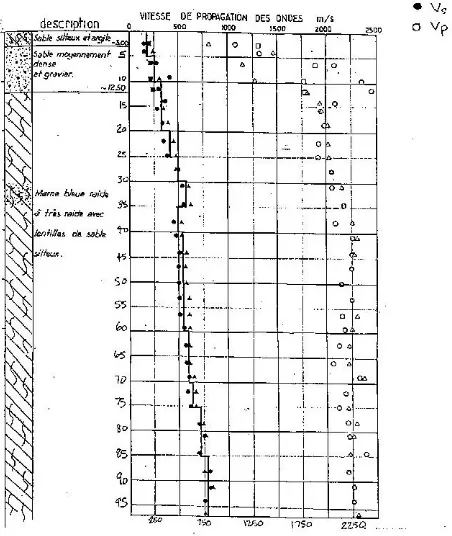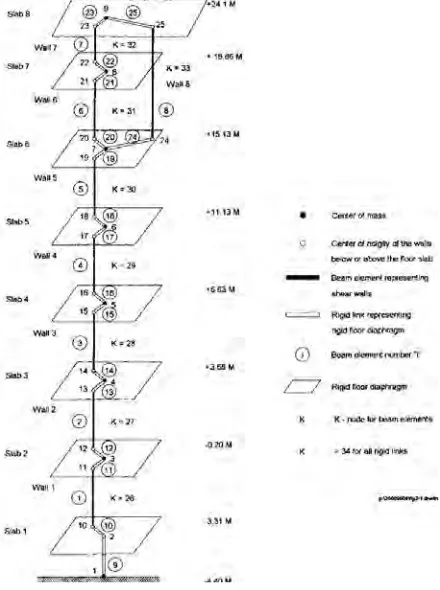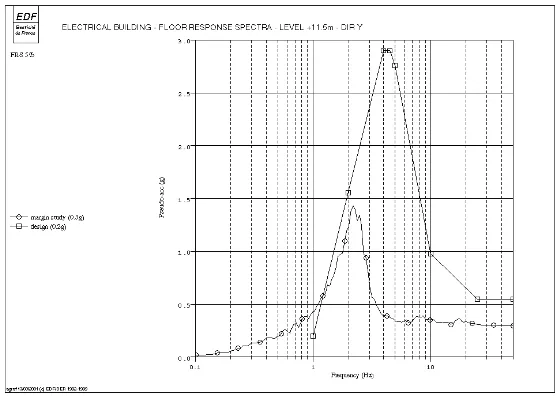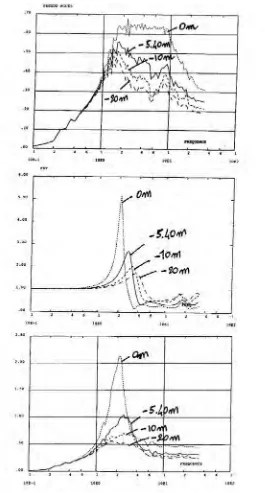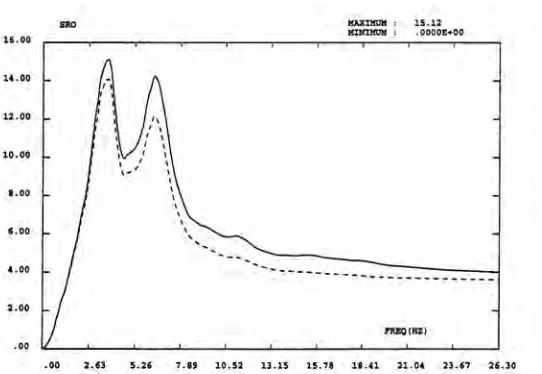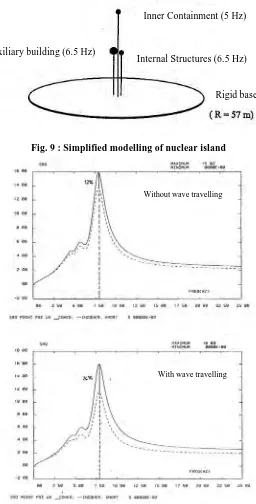French Operating NPP Design Floor Response Spectra : Margins Related to
Soil-Structure Interaction
S. VALLAT, P. A. NAZE, C. DUVAL
Electricité de France, SEPTEN, 12-14 Avenue Dutriévoz, 69628 Villeurbanne Cedex, France
ABSTRACT
Since operating NPP have been designed, state of art in calculation of seismic actions have considerably evolved. Simultaneously the need to demonstrate that margins exist in the seismic design has grown up. These paper tries to investigate the margins that can be found by applying modern calculation techniques to the modelling of actual dynamic soil conditions.
An example study first exhibits the significant margins that can be found on typical alluvium site conditions. Margins result both from the enveloping standard design assumptions and from the important role of foundation depth.
In addition, some recent research investigations on the effect of spatial variation of incident seismic motion are shortly reported. They tend to show that, although modern techniques allow to take into account actual dynamic soil properties, some margins may still remain, especially on typical wide footprint buildings as those of future NPP projects.
INTRODUCTION
French 58 PWR operating nuclear power plants have been progressively designed, built and set in operation since the early seventies.
From seismic design point of view, units have been grouped in series. Among a given series, plants have had a common set of enveloping assumptions concerning soil range and seismic design ground motion.
Since the first series were designed, the state of art in numerical methods for the evaluation of seismic actions have considerably evolved. It is now possible and common to perform realistic enveloping evaluation, taking into account actual measured site soil conditions.
In parallel, rules for the definition of site design ground motion have also evolved. The recently updated French Safety Rule I.2.c now requires specific attention to sites where soft soil properties could possibly induce large amplification, known as “site effects” (cf. [1]). New calculation techniques are to be developed to address this question, especially in the field of transmission of seismic motion through soil layers.
Given this evolution, it appears necessary to clarify whether these knew calculation approaches challenge the seismic margins included in design seismic actions. Therefore this paper concentrates on the evaluation of seismic loads through soil structure interaction.
The work which is reported here is based on research programs conducted par EDF together with CEA. It takes advantage of the experience gained through the participation in Hualien reactor mock-up measurements and international benchmarks analysis.
The paper will first identify the principles which governed the seismic design practice of operating plants, then it will concentrate on the “standard series design” effect together with the influence of foundation depth in the transmission of seismic actions. Finally, a few words will be said about the effect of spatial non coherence of seismic motion.
DESIGN SOIL STRUCTURE INTERACTION METHODS
Simplified seismic analysis methods used in France in the past decades are described in detail in [2]. They are mainly based on modelling of the soil by constant soil spring techniques.
Concerning the evaluation of seismic actions through soil structure interaction calculation techniques, in accordance with Safety Rule V.2.g (cf. [3]), soil is generally regarded as homogeneous isotropic elastic half space, the dynamic Young modulus of which varying in a range wide enough to envelope expected actual site conditions.
Based on analytical impedance functions, soil is modelled using constant soil springs. Soil springs values are given by the impedance functions at the main building-soil frequency. Modal damping results from a weighted sum of internal soil damping, internal structure damping, and soil radiation damping. The weighting values of the sum are proportional to the deformation energy of their relative part of the modelling. In order to introduce some conservatism, the radiation damping is divided by a factor two.
When actual soil conditions of the facility site are known, it has of course to be demonstrated that the design soil range envelopes the actual site conditions. Precise modelling of the soil layers can be used. However this possibility has only been used for the last N4 series design calculations.
MARGINS RELATED WITH STANDARD SOIL RANGE DESIGN
Assumptions and method
In this example study, an attempt is made to characterise the margins in the design floor response spectra of a NPP typical of 900 MWe NPP series. The margins in seismic actions are investigated by comparing on a typical electrical building modelling :
- floor response spectra corresponding to standard design of the series
- floor response spectra resulting from the modelling of actual soil conditions, typical of riverside site
As the objective of the study was to exhibit margins above seismic design, margins ground motion has been taken as a 0.3g wide frequency range spectrum, comfortably enveloping the design ground motion (see Fig. 1)
HORIZONTAL SOIL SPECTRA Damping 5%
0,01 0,1 1
0,1 1 10 100
Frequency (Hz)
pseudo-acceleration (g)
0.3g margins spectrum
0.2g design spectrum
Fig. 1 : Ground motion : 0.3 g margins spectrum compared to 0.2 g standard design spectrum
0
1 0
2 0
3 0
4 0
5 0
6 0
7 0
8 0
9 0
100
0 100 200 300 400 500 600 700 800 900 1000
Shear Wave Velocity Vs (m/s) Depth (m)
Low Strain Cyberquake
Shake
Fig. 3 : Typical alluvium site soil profile. Strain compatible soil properties.
The soil characteristics are typical of alluvium sites. The measured low strain soil profile is given on Fig. 2. Soil characteristics are regularly increasing with depth.
The strain compatible soil profile has been derived from the measured low strain profile by use of soil column non linear calculation techniques. Independent calculation have been performed by two teams. Working for EDF, EQE International used SHAKE program. EDF used CYBERQUAKE French program ([4]). Fig. 3 shows that obtained results are quite identical. The decrease of soil layers mechanical properties is relatively small (~ 10 to 15%)
Whereas design studies have been performed for a wide range of soil dynamic properties (Young’s modulus varying from 500 Mpa to 2000 Mpa ) in order to envelope both riverside and rock site conditions, it appears that the equivalent dynamic properties of this case study correspond to lower bound of soil dynamic properties.
Given these strain compatible properties, seismic actions have been evaluated on a typical stick model of an electrical building, as shown on Fig. 4. The foundation level is at – 5.40 m.
Fig. 5 : Typical alluvium site. Comparison of standard series design floor response spectra with site specific response spectra. Electrical building control room level.
Results and analysis
Fig. 5 shows main results obtained on electrical building.
They reveal that design FRS contain large margins. The peak accelerations are half that of the design spectrum. The revealed margins have also to be increased by the fact that margins ground motion shows acceleration 35 % higher than design ground motion spectrum in the frequency range of interest ( around 1 to 2 Hz).
These important margins result from the following effects :
- as the actual site dynamic soil conditions correspond to the lower side of the design soil range, a typical result is reproduced here, which is that the seismic actions are governed by stiffer soil conditions, due to the more important damping in lower stiffness soils.
- as foundation level is 5.4 m below grade, the incident seismic motion may be reduced as compared to ground motion level.
In order to confirm the origin of the margins, especially concerning the effect of foundation depth, a sensitivity study is proposed in next paragraph.
SENSITIVITY STUDY ON FOUNDATION DEPTH AND EMBEDMENT
Assumptions and method
In order to identify the origin of the margins discovered in Fig. 5, the following sensitivity study has been undertaken. The same modelling of a typical electrical building is used. The strain compatible soil profile is also considered.
The effect of foundation depth on the input motion is investigated. The foundation shape is assumed to be circular, diameter of which is 18 m.
Incident vertical S waves propagate from bedrock towards ground surface and are to be compatible with the margins ground motion spectrum shown in Fig. 1.
Results
Effect of foundation shape and depth are shown on Fig. 6.
Fig. 6a gives the kinematic motion at foundation level. The kinematic motion takes into account the S wave vertical travel towards ground level and the rigid building soil interface. For -5.40 m depth, the incident motion is 20% to 30% lower than ground level motion.
Fig. 6b gives soil-structure transfer function between kinematic motion and floor level. It accounts both for building dynamic behaviour and soil-structure impedance function. As far as foundation depth increases, the dynamic system stiffens and the amplification decreases.
The following comments are to be expressed at this point :
- this study emphasises the beneficial effect of a significant foundation depth and the way it can reduce the dynamic amplification of the seismic motion throughout the buildings height
- the foundation depth, which has often been neglected in seismic design forces calculation of existing plants, is a signification source of margins, especially on typical alluvium sites
- in order to evaluate correctly the influence of foundation depth, special attention has to be put on the actual embedding conditions around the buildings in order to assess the opportunity to assume contact between building and soil along complete or part of building footprint height.
Fig. 6 : Effect of depth of foundation on input motion -a) Foundation level kinematic motion
EFFECT OF SPATIAL INCOHERENCY AND WAVE TRAVELLING
Assumptions, modelling and method
In addition to margins related to soil-structure interaction and especially foundation depth, two other effects can also be investigated, which both refer to the way seismic incident waves reach and excite the buildings : seismic spatial coherency and wave travelling across building basemat.
Design studies generally consider the incident wave as being completely coherent over the basemat surface.
Taking advantage of studies based on Lotung and Hualien experiment field and in-depth ground measurements, a spatial coherence function has been established.
The coherence function has been used to investigate the effect of non-coherence on the seismic response of a PWR nuclear island modelling, the size of which is typical of future PWR projects.
The 3D modelling is presented on fig. 7. Footprint of the buildings is about 100 m wide.
Fig. 7 : 3D modelling of nuclear island typical of future NPP projects
Fig. 8 : Decrease of RB Internal structures service floor response spectra obtained when taking into account spatial non coherence of incident waves across a wide basemat.
Response calculations have been performed using the following methodology: - frequency domain calculation of the response
Results
Soil was assumed homogeneous Vs = 1090 m/s.
Some results are presented on fig. 8. A 10 % reduction of peak acceleration can be obtained at service level of reactor building internal structures. The reduction increases with frequency but remains bounded by relatively low values (30%).
In order to make a distinction between the effects of spatial coherence and wave travelling, a sensitivity study has been performed on a simplified modelling derived from that of Fig. 7.
The simplified modelling is depicted on Fig. 9. Soil is assumed homogeneous Vs =1225 m/s.
Fig. 10 shows that wave travelling and spatial non-coherence can result in about 25 % reduction of seismic actions, half of which coming from each of the effects.
Fig. 9 : Simplified modelling of nuclear island
Figure 10 : Reduction of accelerations related to spatial non coherence and wave travelling. Bottom picture : with wave travelling ; Top picture : without wave travelling.
Auxiliary building (6.5 Hz)
Inner Containment (5 Hz)
Internal Structures (6.5 Hz)
Rigid basemat
More generally this research program has driven the following emerging conclusions :
- when applied on very wide footprint buildings (50 to 100m) spatial non coherence of incident waves leads to reduction of seismic actions
- this reduction is more important on stiff soils, - the reduction increases with frequency
- when coupled with wave travelling effect it may result in significant reduction of about 25% of peak FRS accelerations.
These results are in quite good accordance with the guidelines coming out of EPRI margins studies.
CONCLUSION
Evaluating margins in seismic design of an existing NPP, an important aspect is of course to check that, according to recent earthquake experience findings, no design weak points can be found. Then calculations reflecting the actual features of the plant can be used to obtain updated design values and to express quantitative margins.
Through two example studies, this paper investigated the margins between design seismic actions and revised seismic actions that could be nowadays computed with updated calculation techniques.
The first example study was performed on an electrical building geometry of a typical french 900 MWe NPP built on an alluvium site. Taking into account foundation depth and measured soil layers dynamic properties, we conclude that significant margins can be found between obtained FRS and design FRS. FRS accelerations are divided by a factor of about 2.
The second study illustrates the effect of spatial variation of ground motion. On typical future NPP projects with wide footprints of about 100m, margins in FRS accelerations can reach 10 to 30% depending on the way spatial variation is cumulated with wave travelling effects.
THANKS
The authors express their thanks to CEA research teams in the field of seismic behaviour of building and structures for their support in obtaining part of the results used in this paper.
REFERENCES
1. Règle Fondamentale de Sûreté I.2.c. “Détermination des mouvements sismiques à prendre en compte pour la sûreté des installations nucléaires de base”. Revised in year 2000.
2. J.Betbeder-Matibet, P.Labbe, “Simplified seismic analysis methods in France”, Nuclear Engineering and Design 123, 1990
3. Règle Fondamentale de Sûreté V.2.g “Calcul sismique des ouvrages de génie civil”, 1985
4. M.Brun, P.A.Naze, C.Duval, "New needs for seismic design : near-field earthquake specific studies and site effects evaluations", OECD/NEA Worshop on the Engineering Characterisation of Seismic Input, New-York, 1999
5. N.A.Abrahamson, J.F.Schneider, J.C.Stepp, "Empirical spatial coherency functions for application to soil-structure interaction analysis", Earthquake spectra, Vol.7, no.1, 1991
